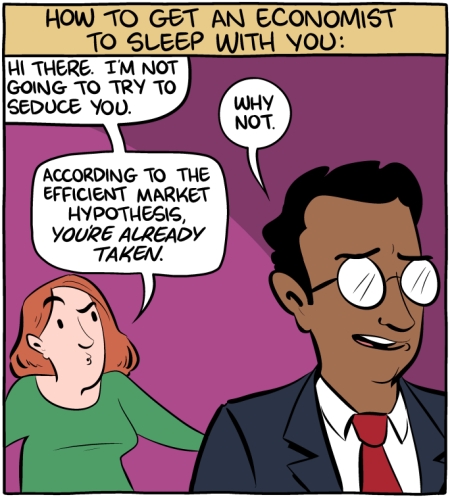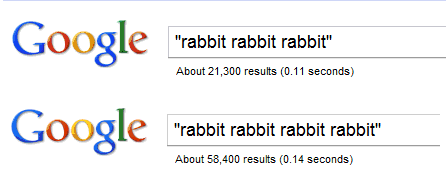(Found on the web with no attribution; I’ll be glad if someone can identify the source for the purpose of proper acknowledgement).
Archive for the 'Fluff' Category
Sometimes you just have to take matters into your own hands.
After posting about the difficulty of finding a modern source for choosing a random city or a random river, I went ahead and created:
I took the data from Maxmind’s free world cities database, but there are odd gaps in it. Although the database lists about 3.3 million cities, the population field is blank for all but about 50,000. (Most notably, that field is blank for all but two of the thousands of cities in the Republic of Korea.) My server offers up a random city from among those 50,000. I’m sure I can probably find a list of Korean cities with populations and manually tack them on to the list at some point. [Edited to add: I’ve just done that.]
Now I want to do something similar for river lengths. Does anyone know where to get the data? (No, pawing through Wikipedia’s hundreds of separate lists, for each part of the world and each letter of the alphabet, is not an option.)
Suppose you want, for some reason, to find the length of a randomly chosen river or the population of a randomly chosen city.
In the old days, we all had things called “reference books”, with long lists of river lengths, city populations, etc. You could open to a random page, close your eyes, put down your finger, and there you’d have it.
But now many of us no longer own reference books. We own smartphones instead. This raises two issues:
1) I’m not sure there are online lists of river lengths or city populations that are as extensive as what you used to find in reference books. Why should there be? Nowadays, if you want to know the population of Des Moines, you just Google for Des Moines; you don’t need a site that lists the populations of thousands or tens of thousands of cities.
2) Even if there were such lists, what would be the modern equivalent of opening to a random page, closing your eyes and pointing? Scrolling for a random amount of time seems less random somehow.
So what do you do?
Science marches on. Recent developments have made it possible to answer the age-old question: What percentage of your college faculty used their work email addresses to establish accounts at Ashley Madison?
In a sample of 33 highly ranked colleges, the answer ranges from a low of 1.6% at Oberlin to a pretty much unbelievable 22.6% at the University of Minnesota. (The full rankings appear at the bottom of this post.)
I got these percentages by counting the number of unique email addresses ending with, say, “harvard.edu” in the leaked Ashley Madison database, and dividing by the number of Harvard faculty, as reported by the college either on its website or in its Common Data Set filings.
The methodology, is, of course, fraught with peril. First, the majority of academic email addresses belong not to faculty, but to students. But it seems like a good guess that faculty (by virtue of their average age) are both far more likely than students to be trolling Ashley Madison, and far more likely than students to be clueless about acquiring anonymous email addresses. Besides, a quick spotcheck of the email addresses in the Ashley Madison database does indeed confirm that most of them (at least in one small but random sample) belong to faculty members.
There are also, of course, staff, and the staff-to-faculty ratio probably varies a lot from school to school, so weeding out the staff could change the relative rankings quite a bit. But again, my (still small but still random) sample continues to indicate that these are mostly faculty members.
A far more important issue might arise from the fact that some universities have multiple campuses. It’s possible, for example, that the 657 umn.edu email addresses in Minnesota’s numerator came from many campuses, while the 2913 facuty in their denominator represents only the main campus. This will tend to inflate the rankings of the big state schools, and might account for the appearance of Minnesota, Virginia, Michigan and Cornell at the top — suggesting that if the numbers were crunched more carefully, the prize might go to Liberty University. If I were going to use these rankings for anything important, I’d give this issue a harder look.
One might also note that anybody can type anybody else’s email address into Ashley Madison, but I’m inclined to discount the importance of that, because it’s hard for me to see what the motive would be (except, perhaps, as part of a campaign to flood someone’s email box with unwanted replies).
With those caveats, feel free to use these rankings as a measure of your college faculty’s average cluelessness, at least when it comes to maintaining anonymity over the Internet.
Continue reading ‘The Ashley Madison Test of College Faculty Cluelessness’
While a team of four has just six interconnections, a team of 16 has 120 interconnections. It is near-exponential growth: n(n-1)/2.
| — Rich Karlgaard and Michael S. Malone |
| Wall Street Journal |
| July 10, 2015 |

So it turns out that if you take a notion to create a crossword puzzle, put it on your blog, and include a “submit” button so that solvers can send you their answers, then — at least if your skill set is similar to mine — writing the code to make that “submit” button work will be about twice as difficult and three times as time-consuming (but perhaps also several times as educational) as actually creating the crossword puzzle. I certainly learned some hard lessons about the difference between POST and GET. But it’s done and (I think) it works.
To do the puzzle online click here. For a printable version, click here. If you do this on line and want to submit your answer, use the spiffy “Submit” button! (And do feel free to compliment the author of that button!). The clues are subject to pretty much the same rules that you’d find in, say, the London Times or the Guardian.
I will gather the submissions and eventually give proper public credit to the most accurate and fastest solvers. Feel free to submit partial solutions; it’s not impossible that nobody will solve the whole thing.
Let’s try to keep spoilers out of the comments, at least for a week or so.
I have one very geeky addendum to all this, leading to a second Monday puzzle — one that might be easy to solve for a reader or two, but most definitely not for me. Unless you’re a very particular brand of geek, you’ll probably want to stop reading right here. But:
A visitor has recently come by my neighborhood, and I’ve snapped a few pictures. What kind of creature is this? When he walks, he (or she?) looks (to me) like a coyote, but when he sits, he looks like a fox. My wife, whose graduate degree is in biology, is as stumped as I am. And they call biology a science!
Ordinarily, of course, I’d ask my government for help, but they’re shut down right now, so I’m forced to rely on the charity of my readers. Can you identify this fellow?

(More pictures under the cut.)
Many years ago, when soft pretzels were available on every street corner in downtown Philadelphia at the going price of
I always thought we could explain that one away as a case of poor math skills. But now our frequent (and frequently brilliant!) commenter Thomas Bayes sends along this photo of a sign that he recently spotted at a gas station convenience store, and which I’m finding a little harder to get my head around:

Thomas reports:
I asked the person behind the counter if she could sell me one pack for $1. She said no. I asked if she would throw one of the packs away for me if I bought two. She seemed genuinely puzzled. I drive an SUV, so I wish they’d apply this scheme to the gas they sell.
Here’s your chance to get creative. Give me an explanation consistent with rational behavior and orthodox economic theory.
Since we’ve been talking about dogs and cats this week:
Hat tip to my sister Barbara.
By the standards of history, you, I, and (unless you’re a very atypical blog reader) pretty much everyone we’ve ever met is fabulously wealthy. How wealthy? One good measure is our ability and willingness to support the frivolity of others. Here are two recent technological innovations that give eloquent testimony to just how well off we are.
First, the Oreo separating machine. (Yes, I realize that every other blogger on earth has already linked to this one, but if you haven’t actually watched it yet, you really should click through):
And then….
 |
 |
A few years back, the British Office of Government Commerce wanted a new logo for etching on (among other things) mousepads and pens, and paid a graphic design firm over $20,000 to come up with this:

Apparently it never occurred to anyone that mousepads and pens are frequently turned on their sides.
Et voila:
The average economist would sacrifice 1.02 years of life to avoid losing a thumb, or .77 years of life to get a paper published in the American Economic Review. An AER publication, then, is worth about 3/4 of a thumb.
We learn this from a study by three economists who sent out 1300 questionnaires, all to economists who had recently published in one of six major journals. They received 85 responses. Of these, 7 were discarded because they claimed to value their thumbs more than their entire hands, or their hands more than their entire arms, and another four were discarded because they indicated they were willing to sacrifice life-years for the privilege of losing a body part. The remaining 74 respondents valued their body parts as follows:
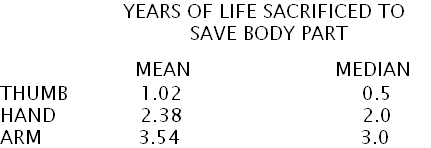

|
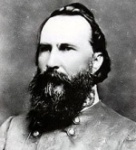
|
The Smithsonian Magazine asks its readers to vote on who had the best Civil War facial hair. Burnside wins, as well he should. But how is Longstreet not even among the candidates?
I didn’t think anyone would get it. I was completely stumped myself until I got help from my friends. But Neil got it.
In his words, “We have onomatopoeaic words for the sounds made by all of the animals on the right.”
Or, as I prefer to think of it, the animals on the right all have vocabularies (consisting, in most cases, of a single word) while those on the left do not.
A donkey brays, and when it brays it says hee-haw. The donkey makes it to the right of the line not by virtue of braying, but by saying hee-haw. Thus the elephant, which trumpets, but thereby merely makes a noise (as opposed to saying a word) is consigned to the left.
Lions, tigers, and jaguars all roar, but to the best of my recollection from extensive reading (mostly at about age 5), lions and tigers, when roaring, actually say the word “roar”, while a jaguar merely roars incoherently. Chickens say “cheep”. Hens say “buck-buck-buck” (the act of saying this is called “clucking”). Roosters can crow in either of two dialects: Some say “rrr-rr-rrr-rr-rrrrr” while others (who my five-year-old self considered unbecomingly pretentious) say “cock-a-doodle-doo”. Pretentious they may be, but as a scientist, I am here to record the facts, not to judge them.
It was said of me in graduate school that “He’s never happy unless he’s making a list”.
My compulsion to make lists has abated over the years, but it lasted long enough that I still find occasional relics lying around.
Recently I ran across the list reproduced below, dating, apparently from my zoology phase, when I was making lists that classified animals according to various criteria. But I was completely unable to recall what criterion had governed this particular list. What rule places the giraffe on the left and the dog on the right?
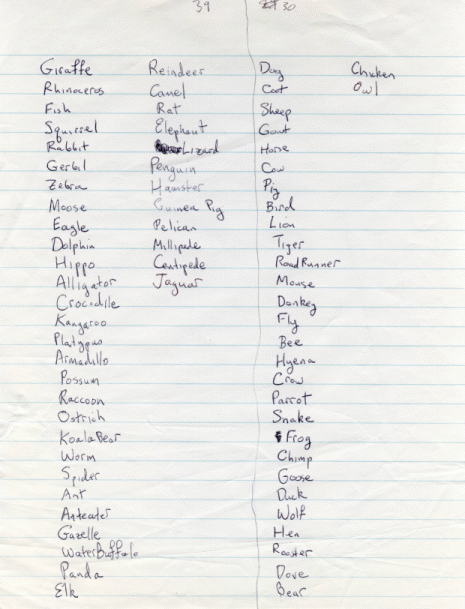
WordPress (which provides the software that drives this blog) provides me with a button that says “delete all spam”. I keep pushing the button, but I’ve noticed that there’s still spam on the Internet. Do I just have to push harder, or what?
My favorite news story of 2010, from the “Police News” section of the Hudson Hub Times:
Hudson — A Sullivan Road resident called police to report a “suspicious package” on his front porch Nov. 2 at 3:20 p.m.
The resident said he observed an unknown person leave the package and called police, according to the police report.
The officer said he could see the package was clearly labeled with the Amazon.com logo and asked the man if he had ordered anything from the firm recently.
The man reportedly said “Why yes, I did.”
The officer told the resident his order had arrived. The resident then said he was comfortable opening the box. The officer then left the scene, according to the report.
Hat tip to my sister.
It has come to my attention that the word astasia refers to both
a. a colorless euglenoid that does not have plastids or a light-sensing spot
and
b. a lack of motor coordination which leaves the patient unable to stand or walk unassisted.
Where is the doggerel that plays off this double meaning? Where are the ironic little vignettes in which the hero (or heroine) is led charmingly astray through the confusion of one meaning with the other?
It’s not like the literary potential of other English double meanings has gone unexploited. (Think “pussy”.) Here is your opportunity to get in on the ground floor of a whole new subgenre. Give me your best astasia wordplay!
(Extra credit: Which chapter of The Big Questions inspired me to look up the word astasia?)
 A few years ago, billionaire David Koch donated $25 million to his alma mater, Deerfield Academy. From his presentation speech:
A few years ago, billionaire David Koch donated $25 million to his alma mater, Deerfield Academy. From his presentation speech:

You might ask: How does David Koch happen to have the wealth to be so generous? Well, let me tell you a story. It all started when I was a little boy. One day, my father gave me an apple. I soon sold it for five dollars and bought two apples and sold them for ten. Then I bought four apples and sold them for twenty. Well, this went on day after day, week after week, month after month, year after year, until my father died and left me three hundred million dollars.
Now on the one hand I love this story. But wouldn’t it have been more plausible if he’d sold the first apple for, say, a nickel?
Well, maybe not much more plausible. Doubling your money every day, it takes just a little over a month to grow a nickel into three hundred million dollars.
I still like the story though.
One year ago today, somewhere in the Phillipines, a reporter checked his web logs and wondered where all the new readers were coming from. Today we celebrate the first anniversary of one of the most unfortunately worded headlines in the history of journalism.
 |
I’ve landed a consulting gig doing real-time optimal path computations for a gentleman who is planning to tour a graph with several hundred million nodes this evening, so I’m taking tomorrow morning off. To tide you over, I leave you with this literary composition, which can be read multiple times for added enjoyment.
Creeps in this petty pace from day to day,
To the last syllable of recorded time;
Eeepps jksaagj effauyp dsajfjkd eepdoos
—Three quarters of an infinite number of monkeys
Do have the best of all possible Christmases.

